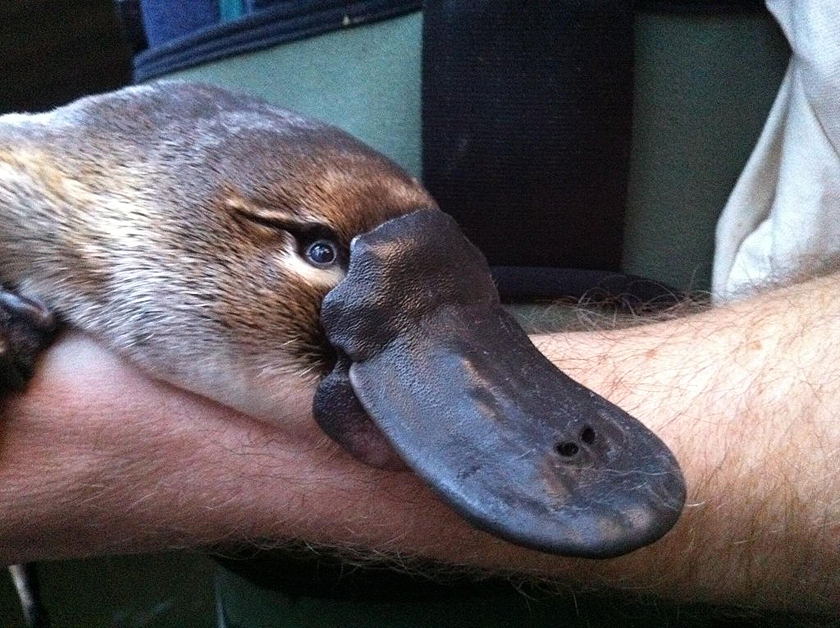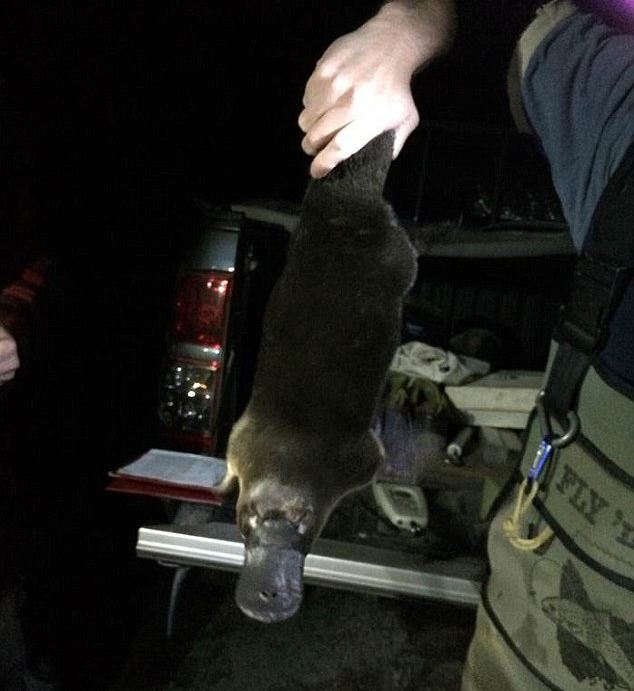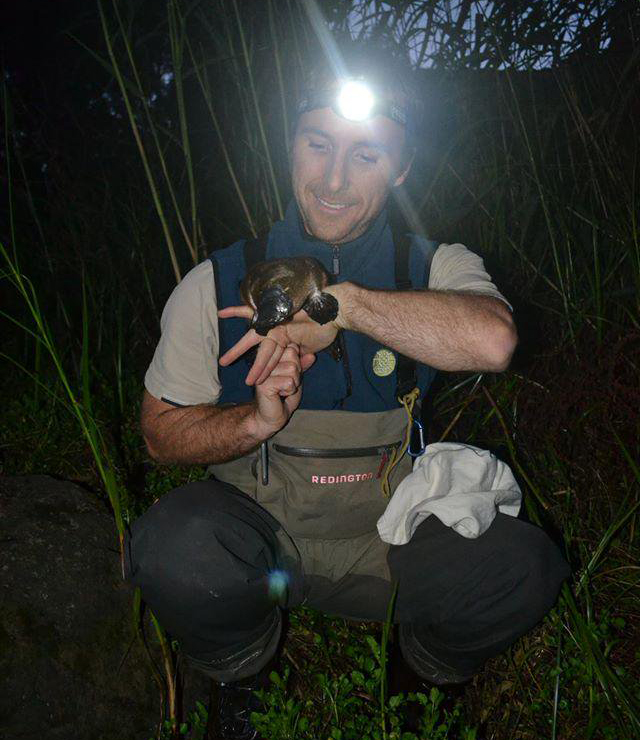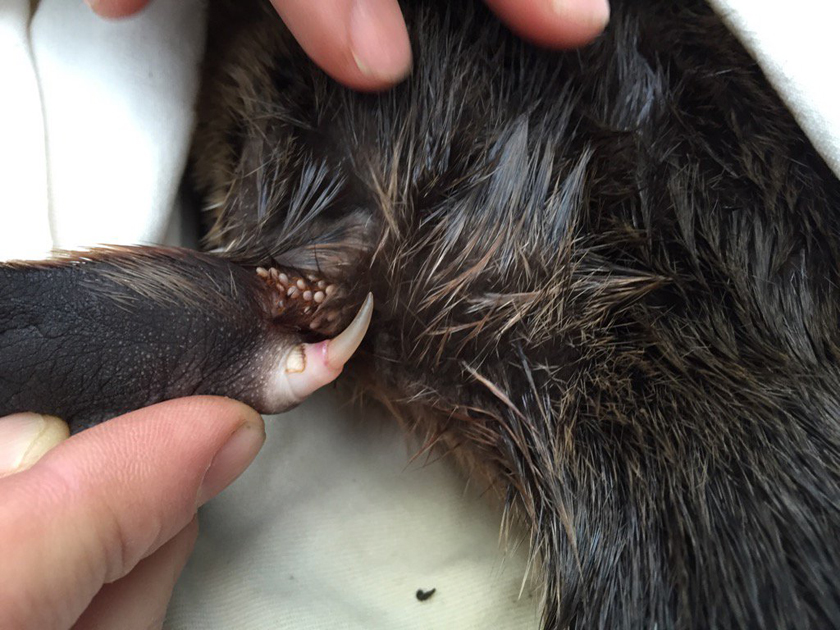Meet The World’s Oldest Wild Platypus
Ecologists surveying the platypus population in Melbourne’s waterways identify a 21-year-old male first tagged in the 1990s.
By Vicki Croke
Platypuses are oddballs: They have leathery duck-like bills, webbed feet, paddle-shaped tails like that of a beaver, and their legs are built in such a way that they walk like reptiles. Photo:Â PlatypusSPOT.
He was out of the water and in the hands of biologists for just 15 minutes, but it was long enough for him to be weighed, microchipped…and for him to keep his record. While most wild platypuses are expected to live no more than 12 years, this guy, called the “grandpa platypus†by an Australian newspaper, and who was first tagged in the mid-1990’s, has reached the grand old age of 21—making him the oldest known wild platypus on record.
Josh Griffiths, senior wildlife ecologist at the Centre for Environmental Stress and Adaptation Research (Cesar), working with a team of students from Monash University, found the super-survivor while on a platypus survey, which he conducts twice a year in Melbourne, Australia.
Josh Griffiths holding the 21-year-old platypus who has been called “grandpa” by one Australian newspaper. Photo: PlatypusSPOT/Cesar.
It could be good genes or good luck or some kind of natural wisdom that have allowed this platypus to survive to an age that is considered to be about twice as long as most of his peers. Griffiths isn’t sure. But he told the Daily Mail that this secretive mammal is “a strong healthy male.†And that part of the explanation might have something to do with a long drought that ended about five years ago in the area. That dry spell reduced the platypus’s population and may have killed off rivals. Platypus numbers have been rebounding since.
Video clip from the spring 2013 platypus monitoring survey by the Melbourne Water Urban Platypus Program. Courtesy: PlatypusSPOT.
Platypuses who get plenty of food and good veterinary care in captivity can live to 21, but in the wild lifespans are usually between seven and 12. And this “Grandpa†is still going strong.
Platypus numbers in Australia and on Tasmania are thought to be pretty healthy. They are not endangered—their conservation status is listed as “least concern.†But ecologists worry about the fact that these semi-aquatic animals require healthy rivers to survive. One of the biggest dangers that “Grandpa†faces is pollution. “Litter continues to be a major problem for platypus,†Griffiths told the Australian Associated Press, “with animals that are entangled enduring cuts, abrasions, a reduced swimming and foraging ability and, finally, a slow death from starvation.â€
Josh Griffiths with a platypus in the field. Photo:Â PlatypusSPOT.
The platypuses he’s studying live in urban areas of Melbourne and are monitored by the Melbourne Water Urban Platypus Program. Residents can help protect them too through a website called PlatypusSPOT where sightings can be viewed and reported.
PlatypusSPOT reports in a blog post dated February 5:
During spring, we conducted live-trapping surveys (capture and release) at 16 locations throughout Melbourne’s five river catchments.
Key findings:
*The survey program captured a total of 21 platypuses (5 adult females, 9 adult males, 2 subadult males, 5 juvenile males).
*The overall catch rate was slightly below average.
*A 21 year-old male was captured at Belgrave, the oldest male recorded in the wild
*Two platypuses (10% of those captured) were discovered entangled in rubber bands. Thankfully, they were freed and released with only minor abrasions.
Any bit of information can help because platypuses are notoriously secretive and, historically, confounding. They are nature’s oddballs. They are mammals—warm-blooded, furry, and they nurse their lima-bean-sized babies. But their milk comes out of pores, not nipples, and the young slurp instead of suck. And they lay eggs (along with echidnas, they are monotremes).
The venomous spur can kill dogs and cause excruciating pain in humans, which can last for months. Photo:Â PlatypusSPOT.
They have leathery duck-like bills, webbed feet, paddle-shaped tails like that of a beaver, and their legs are built in such a way that they walk like reptiles. And, along with some dolphins, they use electrical fields to locate prey (that includes shellfish and insects). In the 18th century, European scientists thought the dead specimens brought to them were a hoax—parts from different animals stitched together to make whole.
The platypus is one of the few mammals in the world that is venomous. The males have venomous spurs on their hind legs and during mating season, they boost their venom production. The toxic sting is strong enough to kill a small dog, and to cause excruciating pain in humans that can last for months.





2 Responses to “Meet The World’s Oldest Wild Platypus”
Love articles like this. Thanks!
An “urban platypus” program! How cool is that! Australian animals are fascinating.
Comments are closed.